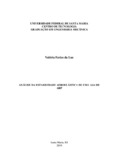Mostrar el registro sencillo del ítem
Análise da estabilidade aeroelástica de uma asa de ARP
| dc.contributor.advisor | Souza, Carlos Eduardo de | |
| dc.creator | Luz, Valéria Farias da | |
| dc.date.accessioned | 2020-01-06T13:59:42Z | |
| dc.date.available | 2020-01-06T13:59:42Z | |
| dc.date.issued | 2019-07-18 | |
| dc.date.submitted | 2019-07-18 | |
| dc.identifier.uri | http://repositorio.ufsm.br/handle/1/19282 | |
| dc.description.abstract | The objective of this work is to perform the aeroelastic analysis of the wing of a remotely piloted aircraft designed and built by the Carancho Aerodesign team, in the year 2017. Aeroelasticity studies the interaction between elastic, inertial and aerodynamic forces present on surfaces subjected to the air flow. These interactions can cause structural damage and consequent problems in the operation of these surfaces. The most common and perhaps most catastrophic form of interaction is a flutter, a self-excitation generated by the coupling of modes of vibration and feedbacked by the flow of a fluid. Determining the frequency and speed at which flutter occurs will be the main focus of the work. For this, it is necessary to perform experimental tests to determine the mass and stiffness matrices of the studied system. These tests were performed statically and dynamically, with the aid of accelerometers and structural excitation mechanisms. After the determination of the structural model, the aerodynamic model is made using a panel method and the aeroelastic analysis is performed using the g-method. At the end of the analysis, the aeroelastic safety of the structure will be verified under a wide speed range. However, this was not the only result, although it is a work devoted to the analysis of a wing of an RPA, the analytical and computational steps that allow the aeroelastic analysis of any flat surface, from the wing of a commercial aircraft to the blades of a wind turbine. | eng |
| dc.language | por | por |
| dc.publisher | Universidade Federal de Santa Maria | por |
| dc.rights | Acesso Aberto | por |
| dc.subject | Aeroelasticidade | por |
| dc.subject | Vibrações | por |
| dc.subject | Aeroelasticity | eng |
| dc.subject | RPA | eng |
| dc.subject | Flutter | eng |
| dc.subject | Vibrations | eng |
| dc.title | Análise da estabilidade aeroelástica de uma asa de ARP | por |
| dc.title.alternative | Analysis of the aeroelastic stability of a RPA wing | eng |
| dc.type | Trabalho de Conclusão de Curso de Graduação | por |
| dc.degree.local | Santa Maria, RS, Brasil | por |
| dc.degree.graduation | Engenharia Mecânica | por |
| dc.description.resumo | O presente trabalho tem por objetivo realizar a análise aeroelástica da asa de uma aeronave remotamente tripulada projetada e construída pela equipe Carancho Aerodesign no ano de 2017. A aeroelasticidade estuda a interação entre forças elásticas, inerciais e aerodinâmicas presentes em superfícies sujeitas ao escoamento do ar. Estas interações podem causar danos estruturais e consequentes problemas na operação destas superfícies. A forma de interação mais comum e talvez a mais catastrófica é o flutter, uma auto-excitação gerada pelo acoplamento dos modos de vibração e realimentada pelo escoamento de um fluido. A determinação da frequência e velocidade em que o flutter ocorre será o foco principal do trabalho. Para isso, faz-se necessária a realização de ensaios experimentais para determinação das matrizes de massa e rigidez do sistema estudado. Tais ensaios são realizados de forma estática e dinâmica, com o auxílio acelerômetros e mecanismos de excitação estrutural. Após a determinação do modelo estrutural, o modelo aerodinâmico é feito utilizando um método de painéis e a análise aeroelástica é realizada através do método g. Ao término da análise constata-se a segurança aeroelástica da estrutura sob uma ampla faixa de velocidade. Contudo este não foi o único resultado, apesar de ser um trabalho voltado para a análise de uma asa de um RPA, são especificados os passos analíticos e computacionais que permitem a análise aeroelástica de qualquer superfície plana, desde a asa de uma aeronave comercial até as pás de um aerogerador. | por |
| dc.publisher.country | Brasil | por |
| dc.publisher.initials | UFSM | por |
| dc.subject.cnpq | CNPQ::ENGENHARIAS::ENGENHARIA MECANICA | por |
| dc.publisher.unidade | Centro de Tecnologia | por |
Ficheros en el ítem
Este ítem aparece en la(s) siguiente(s) colección(ones)
-
TCC Engenharia Mecânica [109]
Engenharia - Habilitação: Engenharia Mecânica


